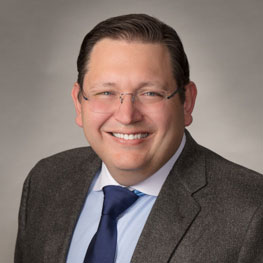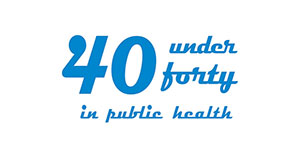General
40 Under 40 in Public Health: Q and A with de Beaumont's Brian Castrucci
 The de Beaumont Foundation recently announced 40 Under 40 in Public Health, a new program that recognizes innovation among young leaders in the field. We asked foundation President and CEO Brian C. Castrucci, DrPH, MA, about the initiative and how this effort can help shape the field going forward.
The de Beaumont Foundation recently announced 40 Under 40 in Public Health, a new program that recognizes innovation among young leaders in the field. We asked foundation President and CEO Brian C. Castrucci, DrPH, MA, about the initiative and how this effort can help shape the field going forward.
Q: Congratulations on the launch of 40 Under 40 in Public Health! What’s your objective for this initiative?
A: Thank you. We hear about the job losses from 2008 that were never recovered. We hear about the budget cuts. Our own PH WINS data suggest that nearly half of today’s workforce may be gone in five years. But despite all this, we know there are amazing people who work every day to build healthier communities across the country, and they represent thousands of others who are doing important work. We chose to highlight early-career leaders because the proportion of millennials in the state and local governmental workforce (ages 23 to 38) is just 22% — compared with 35% in the overall U.S. workforce — and we think it’s important to invest in and encourage this group’s continued success. We also noted that many other programs recognize the highest levels of leadership, but few highlight the promising professionals in our field. By showcasing what’s working, we want to inspire a new generation of professionals who are passionate about leading change in their own communities.
Q: There are many rising stars in public health. I’m sure it wasn’t easy, but how did you choose the honorees?
A: We were overwhelmed with the wonderful response. We easily could have selected 60 or 70 instead of 40. Our judges had a big challenge to narrow the list to 40. Eligible nominees had to be actively working in or in partnership with a state or local governmental public health agency, and they had to be younger than 40 years of age as of Dec. 31, 2019.
Our judges looked for demonstrated leadership and significant contributions made to a nominee’s organization, their community and the public health field. The panel sought nominees who’d fostered collaboration on public health initiatives within and outside of their organizations and across sectors. Creative problem-solving, the implementation of innovative ideas and success in advancing policy solutions were also considered.
In the end, we identified a phenomenal 40 professionals who represent state, city and county health agencies and nonprofit public health organizations across 23 states and one U.S. commonwealth. The honorees are diverse demographically — with 40% being individuals of color and with women comprising 60% of the cohort — and their areas of focus span numerous issues in public health — from HIV, suicide and opioid prevention to environmental health, data, health policy, maternal health and more.
Q: What professional qualities and traits are celebrated as you look at this year’s list?
A: There’s a lot here to celebrate and elevate. Empathy-based problem-solving is among the professional qualities and traits we recognize in this cohort. Alison Traynor, the suicide prevention program director with the North Dakota Department of Health, comes to mind for the work she led to create culturally appropriate suicide prevention programs, including a statewide coalition of 180 suicide survivors and volunteer-led groups, which have been associated with as much as an 80% decrease in suicide death rates.
Honorees have strong analytic skills they’ve used to create and lead evidence-based programs and initiatives. Mark Abraham, the executive director for DataHaven, understood the difference data can make in promoting community health and created the Community Wellbeing Survey program, which partners with more than 100 academic and healthcare institutions, state and local government agencies, and nonprofits to collect, analyze and share data on well-being, public health and economic opportunity.
Courage, collaboration and persuasiveness are other qualities that connect this year’s honorees, from Brittany Marshall with the CDC Foundation, who worked to overcome a culture of STD and HIV stigma, to Joneigh Khaldun, who encouraged a coalition of 25 organizational members from social service organizations, foundations, clinics, hospitals and business partners to work together to develop a comprehensive community health assessment. There are so many great accomplishments. I encourage your readers to review their stories on our website.
Q: Looking ahead, what trends do you see emerging that may be reflected in the work of future nominees?
A: Two major trends among this year’s honorees that are mirrored across the public health field and that I believe we’ll continue to see into the future are social justice and health equity. Many of our honorees work in areas where there’s a need to address underlying social concerns like economic instability and criminal justice issues to make a meaningful impact on community health. They demonstrate an almost innate understanding that healthy communities must be equitable and inclusive communities where the resources needed to strengthen a community’s health are accessible to all, which bodes well for the future for public health practice and the nation.
Q: How do you hope 40 Under 40 advances the field and improves health?
A: Public health professionals often work behind the scenes and don’t get the recognition that professionals in health care and medicine do. By showcasing the honorees’ accomplishments to a national audience, we want to build more understanding of what public health is and why it’s so important to people’s lives. We also want to bring more attention to public health as a professional field and show how exciting and varied this work is.
This isn’t about a list, but creating a movement that will strengthen public health practice for decades to come. I’m proud that we’ve created a way to shine a light on these inspiring public health professionals and on the public health field as a whole.


